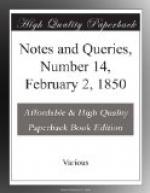“The horse, when he found himself clear of pursuers, stopped his course by degrees, and went with his rider (fast asleep upon his back) into a pond to drink, and there sat his lordship upon the ‘sally.’ (Qy. saddle?)”
P.C.S.S.
St. Philip and St. James.—“And near it was the house of the apostles Philip and James the son of Alpheus.”—Early Travels in Palestine (Mandeville), p. 175.; Bohn’s Antiquarian Library. This is the only place, except in the Church service, where I have seen the above-named apostles coupled together, and have often wondered whether there was any old legend or tradition to account for the Church joining them together in one commemorative festival.
A.H.E.
Sir William Hamilton.—On a tombstone in the burial-ground at St. Hilda’s, South Shields, in the county of Durham, is the following inscription:—
“Here lieth interr’d ye body of Sir W. Hamilton Knt and Baronet sonne to ye Earle of Abercorne and late servant to Queen Henrietta Maria ye late Queene mother of our Soveraigne Lord King Charles that now is over England &c. who departed to ye mercy of God June 24th anno Domni 1681.”
There is in the possession of an old lady living at Durham, in 1836, an original note in the handwriting of King Charles the Second, of which the following is a copy:—
“Whereas a debte of foure thousande one hundred and fifty pounds sterlinge apeares to be remayning dew by the king my father to Sir W. Hamilton brother to the Earle of Abercorne for the service done to the Queene my mother, I do hereby promis to pay ye sayde debte of 4150L. to ye sayde Sir William Hamilton his heires and assigns or to satisfie him or them to the valew thereof when it shall please God to restore me to the possession of my dominions.
“Given at Brussells 28 Mar. 1630.
“CHARLES REX.”
Is any thing known of Sir William Hamilton, or of the services he rendered to Queen Henrietta Maria?
A.H.E.
The Koran by Sterne.—Can you or any of your readers inform me if the work entitled The Koran, printed in some editions of Sterne’s writings, is a genuine composition of his, or not? If not, who was its author, and what is its literary history? My reason for asking is, that I have heard it asserted that it is not by Sterne.
E.L.N.
Devices on Standards of the Anglo-Saxons.—Can any of your readers inform me what devices were borne on the standards of the several Anglo-Saxon kingdoms during the so-called Heptarchy? The white horse is by many supposed to have been the standard of Wessex, and to have been borne by Alfred; but was not this really the ensign of the Jutish kingdom of Kent, the county of Kent to this day displaying the white horse in its armorial bearings? The standard of Wessex is by others said to have been the white dragon;




